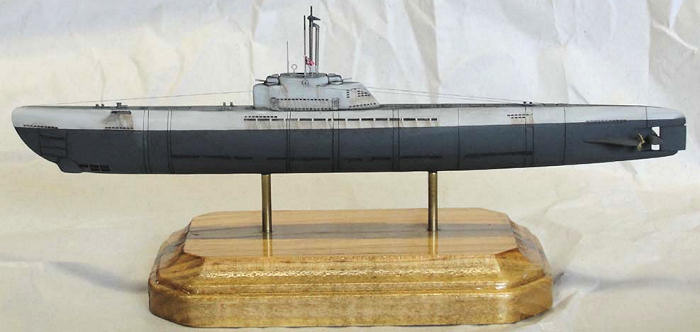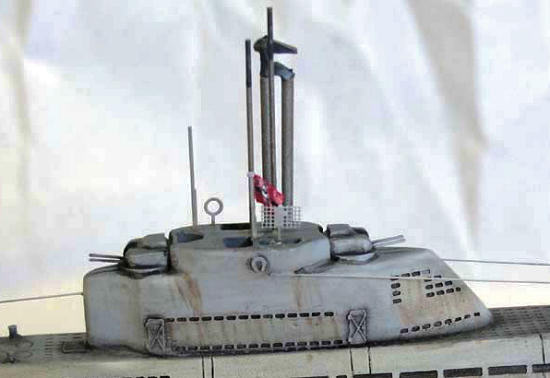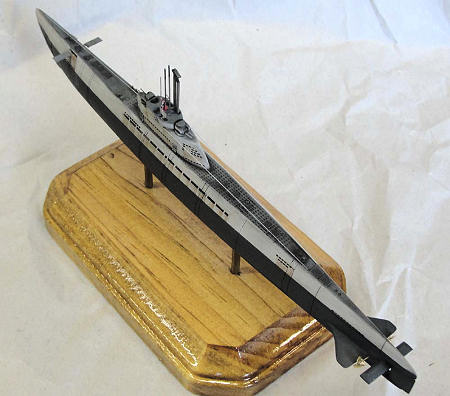Yankee Modelworks 1/350
Type XXI U-boat

The Type XXI Elektroboot was
a weapon that, had it entered service earlier in the war could have won the war
in the
Atlantic
for the Germans. The type XXI was
considered to be the first of the modern submarines.
It was designed from the outset to operate submerged, and not operate on
the surface-only to submerge when danger was near.
 Crew
comforts and space was much improved over earlier classes.
They were among the first German U-boats with freezers for food storage
and a shower.
Crew
comforts and space was much improved over earlier classes.
They were among the first German U-boats with freezers for food storage
and a shower.
They were very
silent, streamlined and hydrodynamically clean.
This allowed for a surprisingly high submerged speed 17.2 kts (31.9
km/h). This gave the boat a
'submerged sprint ability' when positioning itself for an attack.
This high rate of speed even gave the type XXI the ability to outrun many
surface ships WHILE SUBMERGED. This
made the type XXI much harder for the Allies to detect, chase, and destroy.
The Type XXI
even had a hydraulic assisted torpedo reloading system.
With this system the type XXI could reload all six torpedo tubes in
around ten minutes. That was about
the same time as it took for one torpedo tube to be reloaded in the type
VII
boat.
 The
Type XXI had three times the batty power of the VIIc.
This gave the boat an enormous underwater range.
The Type XXI could submerge in the
Bay of Biscay
as it left its bases in
France
and stay submerged far out to sea.
This made the area between the
Bay of Biscay
past
England
to the open sea, also known to the Germans as the
Valley
of
Death,
a worry of the past.
The
Type XXI had three times the batty power of the VIIc.
This gave the boat an enormous underwater range.
The Type XXI could submerge in the
Bay of Biscay
as it left its bases in
France
and stay submerged far out to sea.
This made the area between the
Bay of Biscay
past
England
to the open sea, also known to the Germans as the
Valley
of
Death,
a worry of the past.
The Type XXI could charge
its batteries in about 3-5 hours while submerged with the Schnorchel.
Once the Batteries were charged it would not need to re-charge again for
up to three days depending on its speed.
The type XXI was
so advanced that it influenced submarine construction up into the 1960s.
Only one type XXI is still in existence and it is the U-2540.
The U-2540 was salvaged and re-christened as the Wilhelm Bauer in the new
German Navy to honor the father of German submarine technology.
Wilhelm Bauer’s first submarine was demonstrated in Dec/Jan 1850/51.
The Wilhelm Bauer has been restored and can be visited at the Deutsches
Schiffahrtsmuseum in
Bremerhaven,
Germany.
The kit comes in the classic sturdy Yankee Modelworks box.
The boxes are so nice that I’ve already started to use them to store
stuff in. This kit, like the other
Yankee Modelworks subs consists of a one-piece hull with the conning tower as
part of the hull. The molding is
excellent with not even one bubble.
I’ve always been very impressed by their kits.
The metal parts
consist of a nice fret of photo-etch, six cast metal detail parts and a length
of brass wire for periscopes.
The instructions
are a two-sheet affair with drawings to help with parts placement.
In other words I would say a very nice simple kit.
My first step
was to add two brass rods to the hull.
This I like to do to mount it on a stand and for a few handholds.
I find this quite handy since you don’t have too many things to hold as
you build one of these boats.
I began to
detail the boat with the photo-etch and used cyanoacrylite/super glue to attach
the parts.
 I
like to put most of the detail on the model before I paint.
The only parts that I save for final assembly are the very fine parts
that may be damaged while weathering.
I
like to put most of the detail on the model before I paint.
The only parts that I save for final assembly are the very fine parts
that may be damaged while weathering.
So after
everything was done and the glue was dry the boat was ready to paint.
After everything
was dry I added the fine detail parts and a flag from the excellent sheet by
Tauro. I like stuff like that since
it seems to really bring things to life for me.
I mounted the
whole thing on the stand and rigged with 2lbs fishing line. That really was
about all there was to building this very nice little kit.
 Of
the 118 boats that were completed by the end of the war only four were rated as
operational. When a boat was going
through its sea trials and crew train up it was marked with a series of yellow
bars. Most of these boats were in
just such a color scheme when the war ended.
What I wanted to do was paint my model as one of the operational boats.
Of
the 118 boats that were completed by the end of the war only four were rated as
operational. When a boat was going
through its sea trials and crew train up it was marked with a series of yellow
bars. Most of these boats were in
just such a color scheme when the war ended.
What I wanted to do was paint my model as one of the operational boats.
The paint scheme was
basically three tones of gray. I
first shot on the light gray and after it had dried I masked off the upper hull
and painted all horizontal surfaces a gray that I mixed from the light gray and
anthracite gray. After this I masked off the lower hull and shot it with a coat
of straight anthracite gray.
Now I weathered.
I basically use the same technique to weather this kit as most of my
other builds. That is, I start out
with a very diluted color like rust that is diluted to the point that if I were
to put on one coat you would not be able to detect it.
The secret is layer after layer so it becomes visible.
Well that is about all there
was to it. All in all it was a very
enjoyable build. The kit is small,
only about nine inches long but it is very well cast.
I think that this kit would be a good kit for a beginner since I would
consider it somewhat simple and relatively inexpensive.
Just don’t let the word simple mislead you since it is still a very
detailed little kit.
“U-boats in action”
Squadron/Signal Warships #1
“U-boat War” Squadron/Signal
Books
“The U-boat net”
www.uboat.net
lots of information here.
Kyle BodilyMay 2011
I would like to thank Earls
Hobby Hangar for giving me this review kit.
www.earlshobbyhangar.com
If you would like your product reviewed fairly and quickly, please
contact
me or see other details in the Note to
Contributors.
Back to the Main Page
Back to the Review
Index Page





